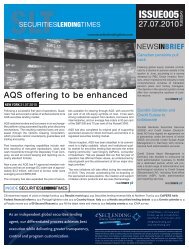Collateral Management - Securities Lending Times
Collateral Management - Securities Lending Times
Collateral Management - Securities Lending Times
You also want an ePaper? Increase the reach of your titles
YUMPU automatically turns print PDFs into web optimized ePapers that Google loves.
PanelDiscussionwhich is to reduce risk. Fortunately, the twogoals—risk reduction and profit in the collateralspace—are not mutually exclusive. There aresome smart safe moves that firms can take torealise both goals at the same time.What can be said is that comprehensive, bestpracticecollateral management is a core riskmanagement process, and managed well it cannot only mitigate losses, but can create opportunityfor profit, through collateral trading, optimisation,and so on.How are firms that act across multipleproduct lines integrating collateralmanagement into their operations?Harland: The concept of enterprise-wide collateralmanagement has been around for some time,but has not been widely put in to practice. However,with the latest market pressures it seems thatthe concept is really coming to life; though it is certainlynot without meaningful challenges arounddata, technology and business structure.Effectively collaborating across internal businesslines may not be easy. Firms will need the buy-inof all the people who are involved, investment intechnology and strong working relationships. Thebenefits, however, could be significant. Breakingdown silos allows for greater transparency, aggregationand control of data, which will lead tooptimisation of collateral. Arguably, it is collateraloptimisation along with liquidity risk managementthat are going to be central to an enterprise-widecollateral management solution.MacAllan: Most firms will already have integratedcollateral management functions, though generallyin product silos, meaning that they are supportingoperations and technology in product streamser—generally when this is the case it is an enormouschallenge to consolidate information across productsand gain a truly cross-product view.But it is becoming clear that being able to viewfirm-wide exposures across product lines, andideally, operate within an entirely cross-productcollateral technology environment, is a priority forfirms. At a recent Lombard Risk webinar event,90 percent of attendees confirmed that ‘crossproduct’was a key strategic aim for their firm.Firms are responding to challenges of the currentenvironment in different ways. Whether theaim is just to provide reporting at a firm-widelevel, or to be able to truly consolidate all marginfunctions into a cross-product environment,firms are focusing on:• Establishing stakeholder(s) to addressglobal, firm-wide collateral managementstrategy, breaking down product-silos andproviding a cross-product view for both bi-lateral and clearing markets• Creating a collateral change programme,engaging front office, treasury and risk andlegal departments• Understanding their technology infrastructureacross all product lines• Understanding the synergies and differencesbetween product lines and technologies• Identifying best of breed from a processperspective• Engaging external vendors and internaltechnology leads to review and establishthe best fit for their defined needs.Awan: <strong>Collateral</strong> management operations arehistorically organised in silos with separatepools of collateral being managed independently,per business line (repo, securities lending,treasury and derivatives) and most oftenby geographical location. On top of regulatoryincentives, the relative scarcity of collateral andthe fundamental transformation that is takingplace in some market segments, such as OTCderivatives, will force firms to better integratetheir collateral management functions.Such integration first requires a deep dive analysisof their current operating models for the managementof the firm’s collateral assets acrossbusiness silos, and who owns or runs them.Often, the treasury function is the biggest singleuser of collateral for funding purposes. However,they are often separated from another key partof the firm’s trading activities—the OTC derivativesor rates business. This part of the firm maybe giving away the firm’s liquidity to meet CCPmargin calls while the treasury is borrowing cash,sometimes from the same counterparty withwhich the OTC derivatives people are trading.MacAllan: Firmsare responding tochallenges of thecurrent environmentin different waysTherefore, the first key decision in redefining anew operating model for collateral managementand optimisation is to appoint a collateral tsar—the owner of all the firm’s collateral assets. Fromthere, a new operating model that crosses businesssilos and trading desks can be defined toserve the collateral and funding needs for all ofthe firm’s business lines. The key point to appreciateis that collateral needs to be managedfrom a single, global pool with a comprehensiveview of the entire collateral inventory.22From an operational perspective, switching toan integrated collateral management model is amajor challenge for the industry. <strong>Collateral</strong> managementis ultimately about anticipating the worstcasescenarios. Given the scale of the current andfuture needs for collateral, the question of ‘do-ityourself’versus outsourcing to a specialised serviceprovider will quickly come on the table.Baauw: Global centralising across multipleproduct lines is the optimal situation, althoughI know that this is very hard to achieve for mostbanks. The problem lies most of the time in thefragmentation of the organisational set up and/or the system infrastructure. I have seen, forexample, some banks using different systemsfor repo and securities lending, with the resultsometimes being that they cannot see the longposition in the system and cover their shorts externally.This is a small example, but when youare looking at the bigger picture at a global bankwith multiple trading disciplines, it is extremelyimportant to have an up-to-date overview of allyour assets across the firm, so that you can runyour collateral management efficiently acrossmultiple product lines. Besides the almost inevitablechallenge to overcome the internalpolitics, you can do this by interfacing a lot ofsystems and decommissioning a lot of systemsto arrive at one over all multiple product systemor put one consolidated multiple asset tradingsystem on top of the existing systems.Newman: The first step is to get a single inventoryof all collateral assets. This gives consumersof collateral the full picture of what is availableto pledge and how that inventory is goingto evolve over time as assets are returned andused. Next you need to understand all the competingclaims on that collateral pool, be theyfrom the OTC derivatives business, exchangetraded instruments, CCPs or the funding andstock lending desks. You also have to satisfycentral bank requirements. The final piece inthe jigsaw is an automated optimisation processthat can take all this information into account,along with the differing haircuts and costs thatare associated with different collateral movements,and produce the optimal assignmentof available collateral to outstanding claims sothat the overall cost of collateral posted is minimised.This needs to be a dynamic processbecause your portfolio will change over time.So the question should not be, ‘What collateralshould I use to meet this new margin call?’There should be a regular review of collateralallocations across the board to understand whatcombination of collateral allocations to collateralrequirements will give the optimal result.Neri: We have helped a number of clients withthis process and there are three elements to successfulcentralisation of collateral management:www.securitieslendingtimes.com












